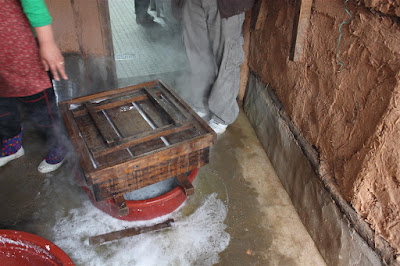Living in a foreign land, one learns to get over such childish fears, partially because it'd be a waste of time to be abroad without sampling the local cuisine, and partially because you have to get pretty good at a foreign language before you can really be picky when ordering. Korea is particularly good for expanding culinary horizons, because no matter what you order, you're likely to wind up with a smörgåsbord of vegetable-and-other side dishes you didn't exactly ask for, most of them so unfamiliar that you won't have had the chance to form any prejudices about them. Most days, I thank Korea for having helped me learn to eat outside the box, so to speak.
Back to topic: I eat tofu so frequently now that I can't imagine there was a time when I refused to eat it at all. It's not that I really love the stuff - actually, I have some apprehensions about it, having read that overconsumption can lead to hormone imbalance, that the soybeans are often GMO, and that it's not safe for humans to depend so greatly on a single plant. Nonetheless, it's everywhere and just about unavoidable, and considering that people have been eating it for hundreds if not thousands of years, it's almost certainly safe when eaten in moderation as part of a balanced died. I had it on its own with just a little spicy sauce as a side dish for Makkeoli (rice wine) last night; the previous weekend, I had it sprinkled with sesame seeds and served with roasted laver and stir-fried kimchi as a compliment to some noodles; it's in just about every vegetarian soup that doesn't contain seaweed; and when it comes in my CSA every month, I turn it into croûtons or just lightly sear it at breakfast time.
After all these years of eating tofu without quite knowing what it was , I was happy to get the chance to participate in the process of making it at Joseon Village. After waking up early, having a light breakfast of fruit, and wandering around a bit getting a feel for the place - as I detailed in a different piece, "Applied Food Ethics at Joseon Village," we happened upon a lady sitting in a hot, smoky, not-quite-indoor-not-quite-outdoor kicthen. She was perching over a giant cooking cauldron which had been excellently designed to be fully integrated into the building's heating system so that not a single ounce of wood would be wasted. She was swooshing around a frothy, white liquid, made by grinding soy beans that had been soaked over night and then adding them to water. They need to be boiled to be cooked thoroughly, and need to be stirred lest they burn to the bottom of the pan. Greg offered to jump in and take a turn.
After boiling the beans and stirring them continuously for the better part of an hour, taking breaks whenever our eyes welled up with tears from the smoke, it was time for the next step: separating the ground beans from the liquid that had absorbed much of their taste and nutrients. I took a giant cloth bag perforated with tiny holes and held it open while the woman scooped out the contents of the cauldron. The sediment remained in the bag, while the liquid escaped through the holes and down into our pot. At the end, I lifted up the sediment-filled bag, and we poured the thinner liquid into a giant rubber tub.
We then sat a big wooden press on top of the tub, plopped the bag of sediment on top of it, and squeezed out all the remaining liquid, leaving us with one tub of very dry grit and one bucket of very beany juice.
Another kitchen worker skimmed some of the liquid off of the top, sugared it, and served us all bowls of fresh, warm, sweet soy milk right on the spot.
After we allowed the same stuff in the red bucket to settle for a while, it turned into this:

Sundubu (순두부), a thin kind of tofu often added to soups. More or less like Silken stuff back home, I believe.
Then, to turn it into the stuff we're used to - the the stuff that come in cubes and holds its shape more or less like Jello - we used this little contraption.
Everything is again poured into a bag, which is itself set inside a little wooden box. The box is closed, a weight is set on top, and left for a few hours. All the liquid drains out (it didn't occur to me to ask what they do with this) and the weight and frame mold the tofu into its eventual form.
Fortunately or unfortunately, we didn't have an hour to wait around. We headed right off to visit some perilla plants (separate post here) and some chickens (and here), all of which we ended up eating (parts of).
In case you're wondering what happens to the grit, worry not: on a conscientious farm, none of it goes to waste. There's a soup called 콩비지찌개 (Kongbiji Jjigae / Bean Grit Stew) that combines the grit with fermented soybean paste, chilli peppers, and a few other vegetables. The grit can also be used to make awesome kimchi pancakes, slightly thicker and more filling than ones made with flour. Or, it can be fed to animals or returned to the land as fertilizer.
All beautiful options. Though, of course, you can also just eat it straight:








No comments:
Post a Comment